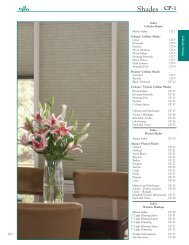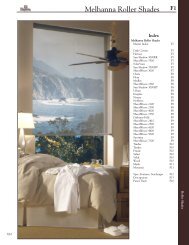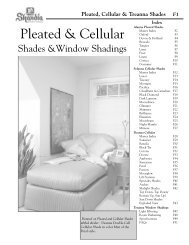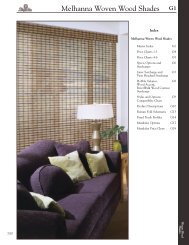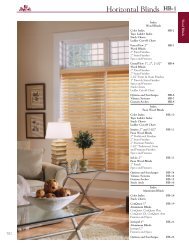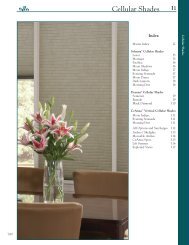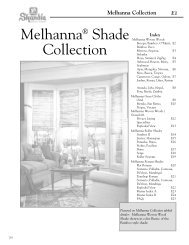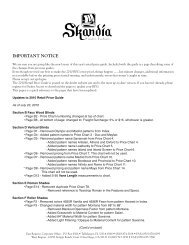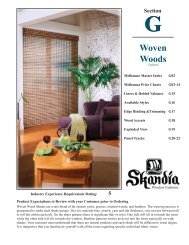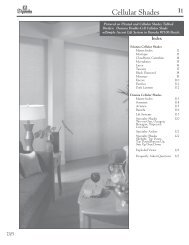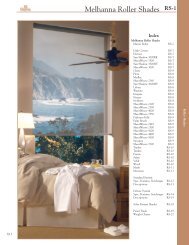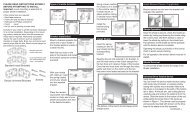Melhanna Collection - Skandia Window Fashions
Melhanna Collection - Skandia Window Fashions
Melhanna Collection - Skandia Window Fashions
You also want an ePaper? Increase the reach of your titles
YUMPU automatically turns print PDFs into web optimized ePapers that Google loves.
E56<br />
<strong>Melhanna</strong> <strong>Collection</strong><br />
Frequently Asked Questions<br />
we hold our vendors. It should not be an issue as long as your<br />
customer orders all the window coverings for a single room at<br />
the same time.<br />
• If wood slats can have bow, camber or twist what problems<br />
might one encounter when using woven wood shade window<br />
coverings?<br />
Like wood blinds fabric can also have bow, camber and<br />
twist. When referring to fabric it is sometimes called bias. All<br />
woven fabrics have bias regardless of fiber content. “Bias” can<br />
be seen in 3 different forms.<br />
Woven woods have all three bias forms present as well,<br />
due to the yarns stretching as the material is woven on looms.<br />
Front to back (twist). A spiral distortion along the<br />
length of a piece of fabric. How the fabric is slit, glued or woven<br />
at the mills is the cause of all<br />
fabric bias twist.<br />
Top to bottom (vertical)<br />
bow is a curvature in the longitudinal<br />
direction causing the<br />
fabric to move away from a flat<br />
plane. Print patterns and stitching<br />
and glue lines make up the<br />
majority of vertical (bow) bias<br />
problems.<br />
Side to side (horizontal)<br />
camber is a curvature of the horizontal direction causing fabric<br />
to move away from a flat plane. Print patterns and stitching and<br />
glue lines make up the majority of horizontal (camber) bias<br />
problems.<br />
We list the acceptable standards used in determining<br />
the bias you may experience under each product’s specifications.<br />
It is important to make your customers aware that these<br />
bias issues are an inherent part of the fabric used in the fabrication<br />
of the product they selected, and are considered normal.<br />
<strong>Melhanna</strong> Grass Cloths<br />
• Will the new grasscloths match in color and texture to<br />
the ones you installed for me last month?<br />
When our suppliers paint, dye or extrude the materials<br />
we use to fabricate our products, there are slight coloration<br />
changes from each run. For example, when our<br />
wood finisher paints slats in our color pure white, the final<br />
color is affected by both temperature and humidity. If one<br />
run is produced when the temperature is 78º and the<br />
humidity is 60% and the next run is produced when the<br />
temperature is 82º and the humidity is 78%, the differences<br />
in temperature and humidity, will cause each run of pure<br />
white slats to vary slightly in color.<br />
• I ordered your Oriel grasscloth pattern and it appears<br />
to be fraying on the edges. Will it unravel?<br />
The unique style of Oriel is quite beautiful, but<br />
Oriel does fray on the edges like a pair of cut off blue jeans.<br />
The size of the frayed edge varies depending on the size of<br />
the shade, and where the material is cut. But it will only fray<br />
to the first yarn line.<br />
• What is considered an acceptable tolerance for color or<br />
texture match?<br />
The commercial tolerance for an acceptable color or<br />
texture match is a 2-foot separation. If there is no discernible<br />
difference between two colors or textures when placed two feet<br />
apart the difference is considered acceptable. The many factors<br />
that influence color and texture make it impossible to paint,<br />
dye, or extrude materials that match perfectly from run to run.<br />
There will always be slight differences. However, our experience<br />
has shown that these differences are not significant and<br />
can only be seen if the materials are placed next to each other.<br />
Holding the materials 2 feet apart, you will not be able to see a<br />
discernible difference. This is the standard to which we hold our<br />
vendors. It should not be an issue as long as your customer<br />
orders all the window coverings for a single room at the same<br />
time.<br />
• Will my window covering discolor or fade?<br />
Discoloration is usually defined as a color that changes<br />
negatively and is generally used to describe a loss in a colors<br />
intensity or the yellowing of the color. Discoloration or fading<br />
can be caused by many factors including but not limited to the<br />
temperature and humidity of the home, chemical cleaning<br />
agents, long-term sun exposure, cigarette or cigar smoke, general<br />
cleanliness of the home and the age of the product. Even<br />
though we use the finest materials available, including the latest<br />
UV (ultraviolet) resistant finishes, a reasonable amount of<br />
discoloration over time is to be expected. The sun’s rays are very<br />
damaging to vinyl and fabric materials. Over time, you can<br />
expect the side of the product that faces the sun to become<br />
slightly faded and a yellow cast or tint may become apparent.<br />
<strong>Melhanna</strong> Roller Shades<br />
• Why does my <strong>Melhanna</strong> roller shade roll up crooked?<br />
Telescoping refers to the material rolling up<br />
unevenly on the roller, resulting in an overhang of fabric on<br />
one end. This can occur if the shade material is not placed<br />
squarely on the roller system. Most of the time, telescoping<br />
is the result of a non-level installation of the roller system.<br />
This generally occurs on an inside-mounted product in a<br />
window casing that is not level to begin with. This product<br />
must be installed perfectly level in order to function properly.<br />
This can be achieved by using a level for an outside<br />
mount installation and a level and shims for an insidemount<br />
installation.<br />
7/04



